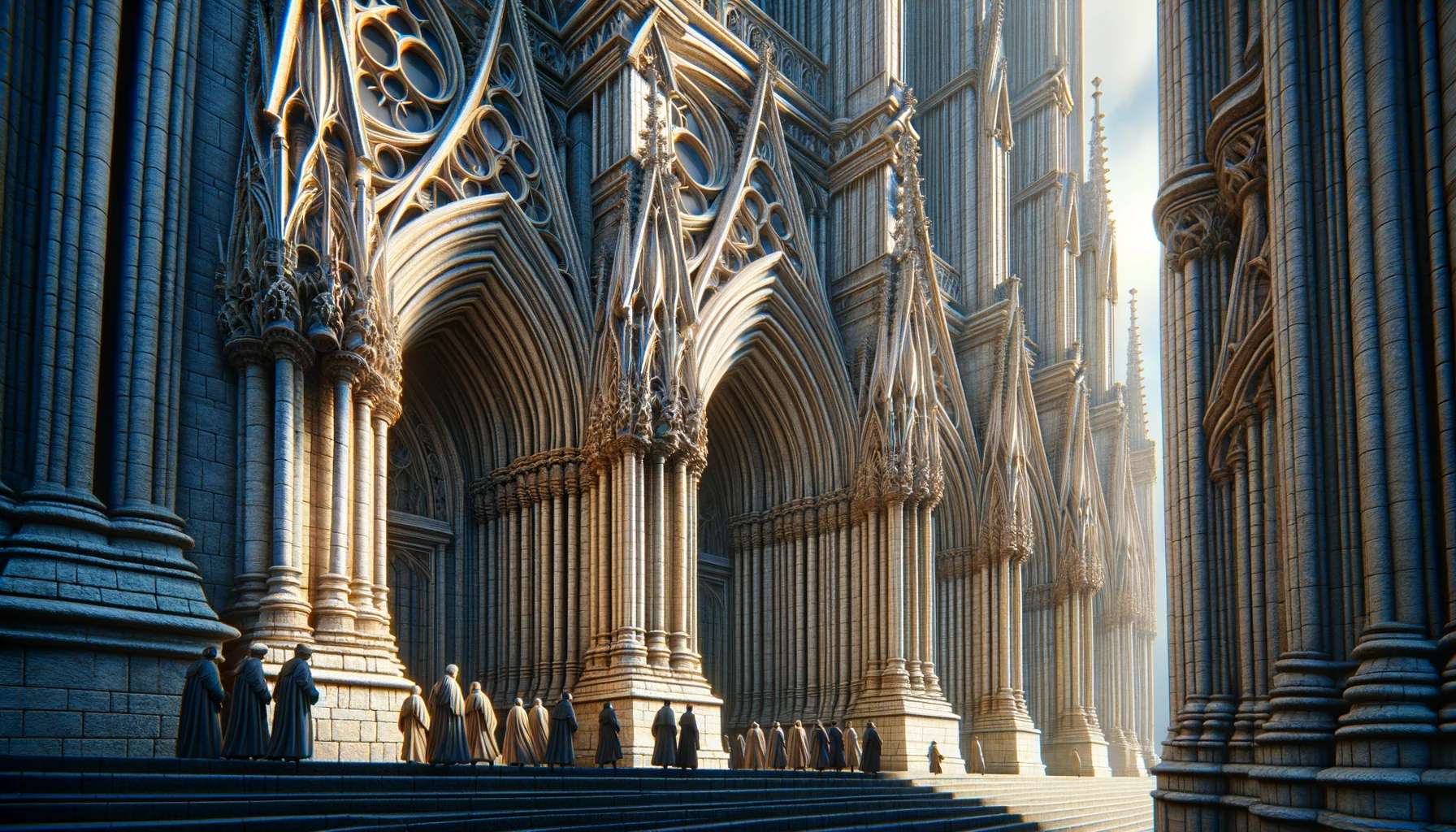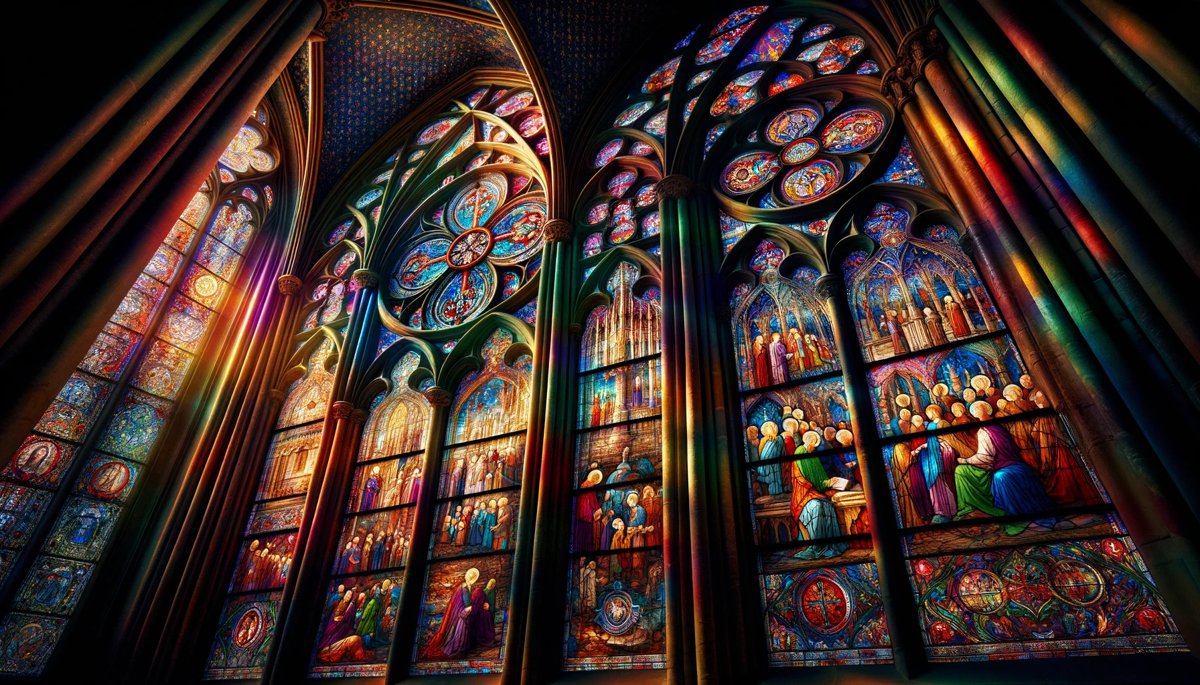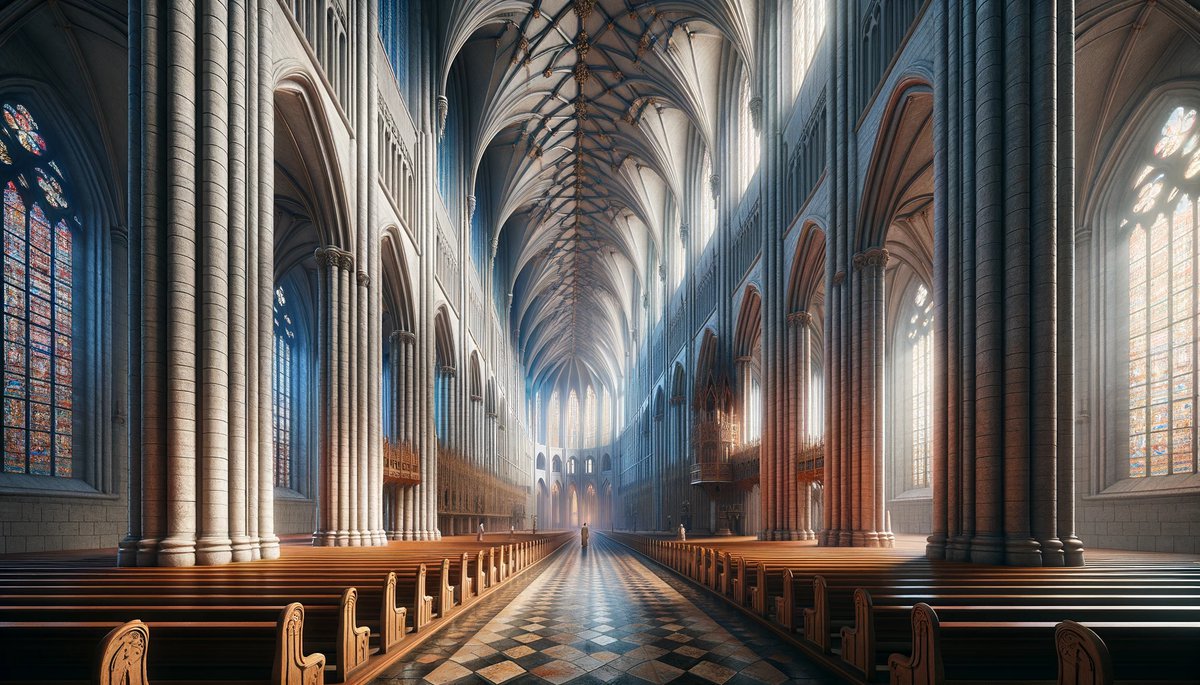Home>Arts and Culture>What Makes A Gothic Cathedral


Arts and Culture
What Makes A Gothic Cathedral
Published: February 18, 2024
Peter Smith, Editorial Director at Christian.net, combines deep insights into faith, politics, and culture to lead content creation that resonates widely. Awarded for his contributions to religious discourse, he previously headed a major organization for religious communicators, enhancing dialogue on faith's societal impacts.
Explore the captivating beauty and intricate design of Gothic cathedrals in this in-depth exploration of arts and culture. Discover the history and architectural marvels that define these iconic structures.
(Many of the links in this article redirect to a specific reviewed product. Your purchase of these products through affiliate links helps to generate commission for Christian.net, at no extra cost. Learn more)
Table of Contents
Introduction
Gothic cathedrals stand as timeless testaments to the ingenuity, artistry, and spiritual devotion of the medieval era. These architectural marvels, with their soaring spires, intricate carvings, and ethereal stained glass windows, continue to captivate and inspire awe in visitors from around the world. The term "Gothic" originally carried a derogatory connotation, as it was initially used to describe the architectural style as barbaric and crude. However, over time, it has come to symbolize a period of great innovation and artistic achievement.
The construction of Gothic cathedrals marked a significant departure from the earlier Romanesque style, characterized by its heavy, fortress-like structures. The transition to Gothic architecture brought about a profound shift in design, emphasizing height, light, and a sense of upward movement. This shift was not merely a matter of aesthetics; it reflected a deeper spiritual and philosophical evolution within medieval society.
Gothic cathedrals were not only places of worship but also symbols of the divine majesty and the aspiration for transcendence. They were intended to elevate the human spirit and inspire a sense of wonder and reverence. The grandeur of these structures, with their pointed arches, ribbed vaults, and flying buttresses, was a testament to the unwavering faith and unwavering determination of the builders.
As we delve into the historical background, architectural features, symbolism, construction techniques, and enduring legacy of Gothic cathedrals, we will gain a deeper appreciation for the profound impact of these magnificent edifices on art, culture, and spirituality. Through this exploration, we will uncover the secrets and stories hidden within the stone walls and stained glass windows, shedding light on the enduring allure of Gothic cathedrals.
Historical Background of Gothic Cathedrals
The emergence of Gothic cathedrals can be traced back to the 12th century, a time of profound cultural, economic, and religious transformation in Europe. This period, known as the High Middle Ages, witnessed the rise of urban centers, the flourishing of trade and commerce, and a renewed zeal for intellectual and artistic pursuits. It was against this backdrop of burgeoning prosperity and innovation that the Gothic architectural style took root and flourished.
The development of Gothic architecture was closely intertwined with the rise of the medieval Church as a dominant cultural and political force. As the Church sought to assert its authority and magnificence, it turned to architecture as a means of expressing its power and grandeur. The construction of monumental cathedrals became a tangible manifestation of the Church's influence and a reflection of its aspirations for spiritual transcendence.
One of the most iconic examples of early Gothic architecture is the Abbey Church of St. Denis near Paris, often credited as the first true Gothic building. Commissioned by Abbot Suger in the 12th century, the church's innovative design departed from the heavy, fortress-like structures of the Romanesque style. Instead, it embraced a new aesthetic characterized by soaring heights, expansive windows, and a sense of weightlessness. These architectural features aimed to create an ethereal, heavenly atmosphere within the sacred space, inviting worshippers to gaze upward in awe and contemplation.
The Gothic style quickly gained momentum and spread across Europe, giving rise to a proliferation of magnificent cathedrals in France, England, Germany, and beyond. Each region infused its own cultural and artistic influences into the Gothic idiom, resulting in a rich tapestry of regional variations and stylistic nuances.
The construction of these monumental edifices was a monumental undertaking that required the collective effort of architects, stonemasons, artisans, and laborers. The sheer scale and complexity of Gothic cathedrals reflected the ambition and dedication of the communities that built them, as well as the patronage of powerful rulers and ecclesiastical authorities.
As Gothic cathedrals continued to evolve and expand in the following centuries, they became not only architectural marvels but also symbols of civic pride, spiritual devotion, and artistic achievement. Their enduring legacy continues to inspire wonder and admiration, serving as a testament to the creative and spiritual heights that humanity can reach.
Architectural Features of Gothic Cathedrals
Gothic cathedrals are renowned for their distinctive architectural elements, which collectively contribute to their ethereal beauty and structural innovation. These features not only showcase the technical prowess of medieval builders but also serve as profound expressions of spiritual and artistic aspirations.
1. Vertical Emphasis:
One of the defining characteristics of Gothic architecture is its verticality. Gothic cathedrals soar to great heights, with towering spires and expansive interiors that seem to reach towards the heavens. This emphasis on height was achieved through the use of pointed arches, ribbed vaults, and clustered columns, which allowed for greater structural stability and the ability to support taller walls and ceilings.
2. Flying Buttresses:
Gothic cathedrals are often adorned with external supports known as flying buttresses. These graceful, arched structures extend from the exterior of the building to counteract the outward thrust of the vaulted ceilings, thereby providing essential reinforcement and allowing for the inclusion of expansive stained glass windows. The flying buttresses not only serve a practical function but also contribute to the visual drama and elegance of the cathedral's exterior.
Read more: What Did A Gothic Cathedral Symbolize
3. Stained Glass Windows:
One of the most captivating features of Gothic cathedrals is the use of stained glass windows. These luminous works of art depict biblical narratives, saints, and symbolic motifs, suffusing the interior spaces with a kaleidoscope of colored light. The intricate tracery that frames the stained glass panels adds to the ethereal ambiance, creating a sense of divine illumination within the sacred precincts.
4. Ribbed Vaults:
The interior of a Gothic cathedral is often adorned with ribbed vaults, which are intersecting arched supports that distribute the weight of the ceiling and create a visually striking pattern. The use of ribbed vaulting allowed for greater height and spaciousness within the cathedral, while also enabling the inclusion of elaborate ceiling decorations and sculptural elements.
5. Pointed Arches:
Unlike the rounded arches of Romanesque architecture, Gothic cathedrals feature pointed arches that impart a sense of upward movement and grace. These arches not only contribute to the vertical thrust of the building but also create a sense of rhythm and harmony, lending a sense of ethereality to the architectural composition.
6. Sculptural Decoration:
Gothic cathedrals are adorned with an abundance of sculptural ornamentation, including intricately carved capitals, gargoyles, and decorative reliefs. These sculptural elements serve as both embellishments and symbolic expressions, depicting scenes from scripture, allegorical figures, and fantastical creatures that populate the margins of the sacred space.
The architectural features of Gothic cathedrals collectively embody the aspirations of medieval society to create spaces that transcended the earthly realm and evoked a sense of divine splendor. Through their innovative design and spiritual symbolism, these cathedrals continue to stand as enduring masterpieces of human creativity and devotion.
Symbolism and Meaning in Gothic Cathedrals
Gothic cathedrals are imbued with rich symbolism and profound meaning, serving as visual allegories of the Christian faith and encapsulating the theological and spiritual aspirations of the medieval era. Every architectural element and decorative motif within these sacred spaces carries symbolic significance, inviting worshippers to contemplate the mysteries of divine revelation and the promise of salvation.
-
Verticality and Ascent: The towering spires and soaring vaults of Gothic cathedrals symbolize the human yearning for transcendence and the ascent towards the divine. The upward movement of the architecture reflects the belief in the heavenly realm and the eternal pursuit of spiritual enlightenment.
-
Light and Illumination: The radiant stained glass windows, suffusing the interior with a kaleidoscope of colors, symbolize the divine light of God shining upon the faithful. The interplay of light and shadow within the sacred space evokes the contrast between earthly existence and the divine presence, inspiring contemplation and awe.
-
Biblical Narratives and Saints: The sculptural reliefs and stained glass depictions of biblical narratives, saints, and martyrs serve as visual reminders of the Christian narrative and the lives of exemplary figures. These representations offer a didactic function, conveying moral lessons and theological truths to the illiterate masses.
-
Gargoyles and Grotesques: The presence of gargoyles and grotesque figures on the exterior of Gothic cathedrals serves as a symbolic expression of the struggle between good and evil. These fantastical creatures, often depicted in contorted forms, were believed to ward off malevolent forces and protect the sacred precincts from spiritual malevolence.
-
The Cross and Crucifixion: The cruciform layout of Gothic cathedrals, with the central nave intersected by transepts, serves as a potent symbol of the crucifixion of Christ and the redemptive sacrifice. The cross-shaped plan of the cathedral reinforces the centrality of Christ's salvific act within the Christian faith.
-
Sacred Geometry and Proportions: The meticulous attention to geometric harmony and proportional balance in Gothic architecture reflects the belief in the divine order and the cosmic significance of mathematical principles. The harmonious proportions of the cathedral's design were seen as a reflection of the divine wisdom and the perfection of creation.
The symbolism embedded within Gothic cathedrals transcends mere ornamentation; it serves as a visual language through which the profound truths of the Christian faith are communicated. Each architectural element and decorative motif contributes to the overarching narrative of salvation and spiritual enlightenment, inviting worshippers to engage in contemplation and prayer within the awe-inspiring embrace of these sacred spaces.
Construction Techniques and Innovations
The construction of Gothic cathedrals represented a pinnacle of architectural achievement during the medieval era, showcasing remarkable technical ingenuity and innovative building methods. The realization of these monumental edifices required the mastery of sophisticated construction techniques and the development of groundbreaking innovations that pushed the boundaries of engineering and craftsmanship.
1. Stone Masonry and Structural Stability
Gothic cathedrals were predominantly constructed using stone masonry, with massive blocks of limestone, sandstone, and granite forming the primary building materials. The use of stone allowed for the creation of sturdy load-bearing walls and towering spires, ensuring the structural stability and longevity of the edifice. Skilled stonemasons meticulously carved and fitted each stone block, employing precise joinery techniques to create seamless, interlocking surfaces that could withstand the immense weight of the vaulted ceilings and walls.
2. Ribbed Vaulting and Pointed Arches
One of the most significant innovations in Gothic architecture was the introduction of ribbed vaulting and pointed arches. These architectural elements revolutionized the distribution of weight within the cathedral, allowing for the creation of expansive, open interiors and soaring ceilings. The ribbed vaults, composed of intersecting arched ribs, provided greater structural support and enabled the construction of larger, more intricate ceiling designs. The pointed arches, with their inherent strength and graceful form, facilitated the creation of taller, more slender columns and the incorporation of expansive stained glass windows.
3. Flying Buttresses and Lateral Support
The incorporation of flying buttresses represented a groundbreaking advancement in Gothic construction techniques. These external masonry supports, characterized by their graceful, arched profiles, served to counteract the outward thrust of the vaulted ceilings, providing essential lateral support and preventing the walls from buckling under the weight of the roof. The innovative use of flying buttresses allowed for the creation of expansive clerestory windows and the infusion of natural light into the interior, while also contributing to the visual drama and elegance of the cathedral's exterior.
4. Scaffolding and Hoisting Systems
The construction of Gothic cathedrals necessitated the development of sophisticated scaffolding and hoisting systems to facilitate the assembly of the towering structures. Wooden scaffolds, erected both inside and outside the cathedral, provided access for craftsmen and laborers to work at great heights, allowing for the intricate carving of decorative elements and the installation of sculptural adornments. Additionally, the use of pulleys and hoists enabled the transportation and positioning of massive stone blocks and building materials, streamlining the construction process and ensuring precision in the assembly of the cathedral's intricate components.
5. Innovations in Glassmaking and Stained Glass Artistry
The advent of Gothic architecture coincided with significant advancements in glassmaking techniques, leading to the creation of exquisite stained glass windows that adorned the cathedral interiors. Artisans developed innovative methods for producing vibrant, translucent glass panels, which were then meticulously assembled into intricate designs depicting biblical narratives, saints, and symbolic motifs. The use of lead cames to join the individual glass pieces allowed for the creation of elaborate, multicolored compositions that suffused the sacred spaces with a celestial glow, transforming the play of light into a transcendent experience for worshippers.
The construction techniques and innovations employed in the creation of Gothic cathedrals not only reflected the technical prowess of medieval builders but also embodied a profound commitment to transcending earthly limitations and aspiring towards divine splendor. These monumental achievements in architectural engineering continue to inspire awe and admiration, serving as enduring testaments to the creative and spiritual heights that humanity can attain.
Influence and Legacy of Gothic Cathedrals
The influence and legacy of Gothic cathedrals extend far beyond their architectural significance, permeating the realms of art, culture, and spirituality. These monumental edifices have left an indelible imprint on the collective consciousness of humanity, shaping the aesthetic sensibilities, religious practices, and intellectual pursuits of successive generations.
Artistic Inspiration and Innovation
Gothic cathedrals have served as wellsprings of artistic inspiration, influencing a myriad of creative endeavors across the centuries. The intricate carvings, sculptural reliefs, and vibrant stained glass windows of these sacred structures have inspired generations of artists, from the luminaries of the Renaissance to the avant-garde visionaries of the modern era. The ethereal beauty and spiritual symbolism embodied in Gothic artistry continue to captivate and inform contemporary artistic expression, serving as a testament to the enduring power of these architectural masterpieces.
Cultural and Spiritual Significance
The cultural and spiritual significance of Gothic cathedrals transcends their function as places of worship. These monumental edifices have served as focal points for communal gatherings, religious processions, and civic celebrations, fostering a sense of collective identity and civic pride within their respective communities. Moreover, the enduring presence of Gothic cathedrals has provided solace, inspiration, and a sense of continuity in the face of historical upheavals and societal transformations, serving as enduring symbols of resilience and spiritual fortitude.
Architectural and Engineering Legacy
The architectural and engineering innovations pioneered in the construction of Gothic cathedrals have reverberated throughout the annals of architectural history, influencing subsequent building techniques and design principles. The emphasis on structural stability, verticality, and the infusion of natural light has informed the evolution of architectural styles and construction methodologies, leaving an indelible mark on the built environment. The enduring legacy of Gothic architecture can be discerned in the soaring skyscrapers, luminous cathedrals, and innovative structural designs that continue to shape the urban landscape.
Enduring Symbol of Human Aspiration
Above all, the legacy of Gothic cathedrals endures as a testament to the heights of human aspiration and the enduring quest for transcendence. These monumental edifices stand as tangible expressions of the human spirit's yearning for beauty, meaning, and connection to the divine. Their enduring allure serves as a reminder of the profound capacity of humanity to create, inspire, and reach towards the ineffable, transcending the constraints of time and space.
In essence, the influence and legacy of Gothic cathedrals resonate across the tapestry of human experience, embodying the timeless pursuit of beauty, faith, and the eternal quest for the divine. Their enduring impact serves as a testament to the enduring power of human creativity and the enduring resonance of spiritual aspiration.











